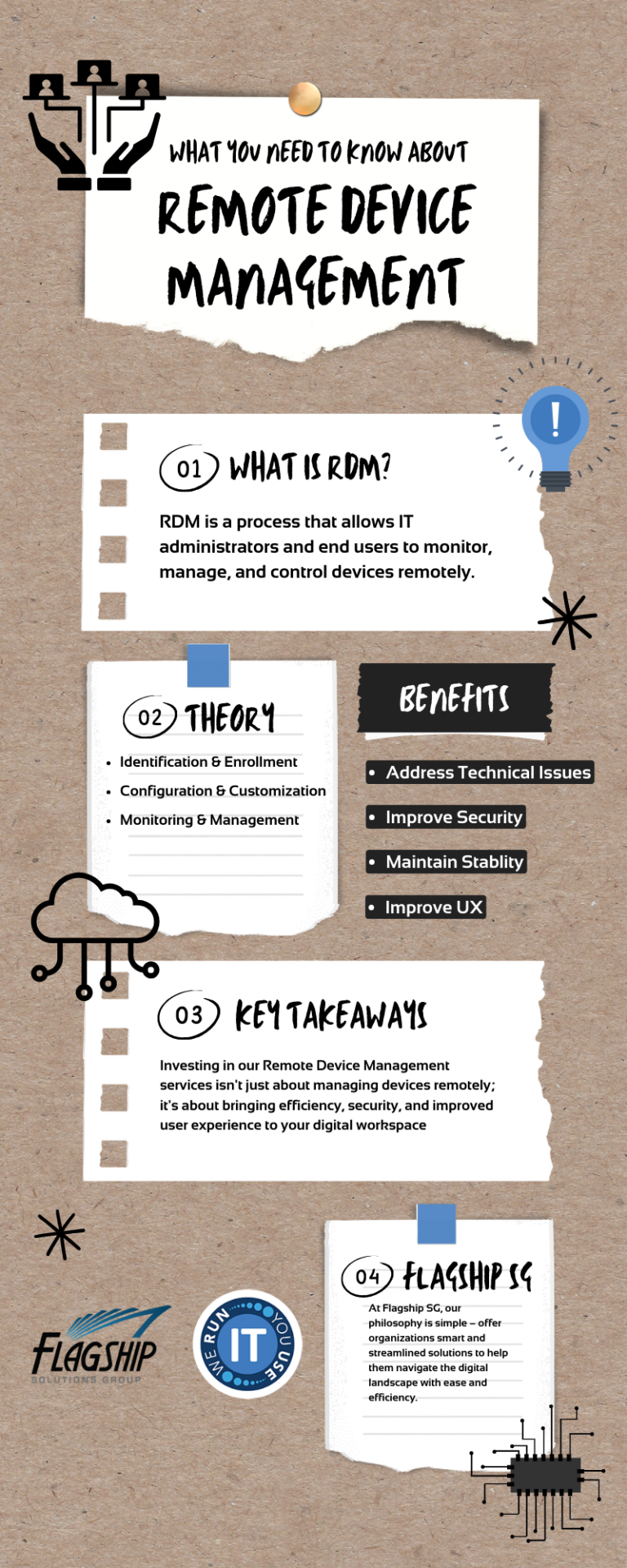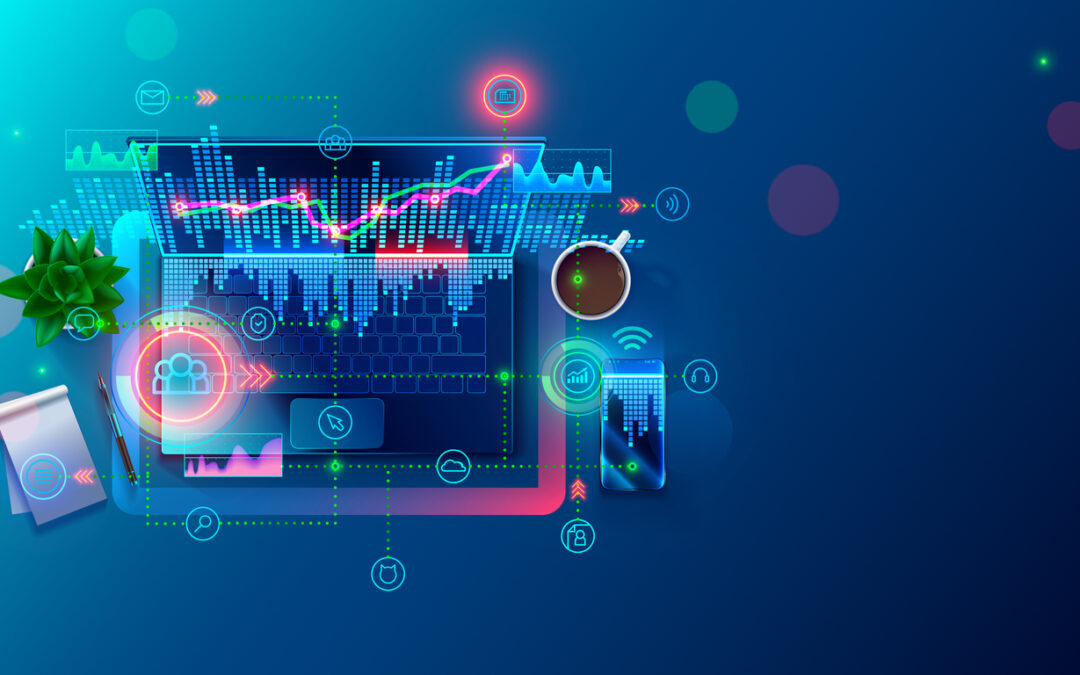In the constantly evolving landscape of technology, managing numerous devices and systems across a vast network has become a complex challenge for many organizations. Ensuring optimum performance and security for every single device is of critical importance. This is where Remote Device Management comes in. But what exactly is remote device management? And, how vital is it in the digital era we are living in?
Remote Device Management (RDM) is a sophisticated technology designed to monitor, manage, and troubleshoot devices from a centralized location – efficiently and securely. From administering system upgrades to fixing technical glitches, RDM creates an environment where every device, be it one or hundreds, can be managed seamlessly, reducing the need for on-site visits and making device management practical and more efficient.
So, who could help you unlock the maximum potential of remote device management? This is where Flagship SG comes in.
Flagship SG is a leading provider of innovative solutions, specializing in a diverse array of managed services including IT infrastructure optimization and evaluation, facilities services, security, cloud, and importantly, Remote Device Management. With over a decade of experience, Flagship SG takes on your IT conundrums and delivers efficient, innovative, and reliable solutions. Flagship offers an exhaustive range of remote-enabled services engineered to drive your business processes forward while offering optimal control over your diverse device inventory.
Understanding Remote Device Management
To fully understand the power of Remote Device Management (RDM), we must first break down its core principles and components. Simply put, RDM is a process that allows IT administrators and end users to monitor, manage, and control devices remotely. Whether it involves an Android device, a Windows system, a ChromeOS laptop, or even an IoT device, RDM enables centralized control over all these devices.
Furthermore, RDM isn’t restricted to just desktops and laptops. Today, a variety of mobile and IoT-connected devices can be monitored and managed remotely as well, thanks to an array of RDM software available in the market. Whether accessed through apps, web interfaces, or admin consoles, this software allows organizations to maintain control of their devices anytime, anywhere.
Remote monitoring and remote access are two components foundational to RDM. Remote monitoring involves real-time tracking of key aspects like device location, device performance, network and internet connections, adherence to set corporate standards, and more. On the other hand, remote access affords IT administrators the ability to troubleshoot devices – be it software malfunctions, connectivity issues, firmware updates, etc. – from a remote location.
The prologue to any remote device management process begins with device enrollment. This refers to registering a new device into the remote device management platform once it’s connected to the internet. Each device is also identified by a unique serial number. Then, settings and specifications are configured in the device as per the user or the organization’s requirements.
The terminologies associated with RDM might seem daunting at first, but once you understand its functionality, it all coalesces into a gripping picture of how effective and impactful this technology can be for organizations. It’s an ecosystem built for user convenience, safety, and efficiency. Now that you have a better grasp of RDM’s basics let’s peek into the mechanics and processes that render its strength in action.
The Process and Mechanism behind Remote Device Management
Remote Device Management (RDM) is a multi-faceted technology blend of systems and protocols designed to manage devices from a centralized location. It encapsulates several steps from recognizing individual devices to managing device configuration and settings.
In terms of organization, RDM platforms utilize specific identifiers for each device, from serial numbers to device types – enabling precise cataloging and tracking. Once a device is identified, it’s then registered – or in RDM parlance, “enrolled” – into the system. This enrollment phase associates the device with a user, if applicable, and establishes the basic settings and parameters for its operation.
Once the device is registered, it’s time for configuration. Customization of device settings is a crucial part of RDM, allowing for a tailored user experience. This process includes everything from network connection settings, security preferences, and app installations to OS updates and access permissions.
Beyond the initial setup, the real strength of RDM comes from its monitoring and management capabilities. With the help of RDM software, it becomes possible to monitor device performance, make adjustments to device settings, and even control apps on individual devices in near real-time. The key is that all of these actions can be performed remotely, without the need for physical access to each device. This feature is especially useful when devices require troubleshooting or firmware updates – actions that can be executed swiftly and efficiently from a centralized location with RDM.
Moreover, RDM affords IT administrators the luxury of performing various maintenance tasks. This can include but is not limited to, installing software and security updates, administering content management, and ensuring the safety and privacy of the organization’s data and the end user’s personal information are not compromised.
The Benefits and Impact of Remote Device Management
Remote Device Management (RDM) goes beyond mere device control and real-time troubleshooting. Indeed, the unique capabilities of this technology offer several advantages that can considerably influence an organization’s overall functionality and productivity.
Addressing Technical Issues
Firstly, RDM simplifies addressing technical issues. The ability to identify and rectify problems from a centralized location eliminates the need for on-site technical assistance. This translates to quick and efficient resolution of issues, causing minimal disruption to the end user’s activities and the organization’s daily workflow.
Improve Security Measures
Security, without a doubt, is a prime concern for organizations today. Remote device management bolsters security measures, providing businesses with control over their devices even if they are miles away. Potential threats can be quickly identified and neutralized, ensuring that the corporate data remains secure. This includes everything from the deployment of security updates to enforcement of security policies across all devices.
Stable Connections
Optimal network and internet connections are indispensable for most operations nowadays. By continuously monitoring these connections, RDM aids in maintaining a stable and secure connection. Alerts can be configured to flag when a device drops its connection or encounters other network-related issues, enabling swift interventions and reducing downtime.
Improved User Experience
Enhanced user experience is another significant benefit of RDM. By customizing device settings remotely, businesses can ensure that users have access to the right resources and tools. Organizations can also administer content and application management, ensuring relevancy and productivity.
On a broader scale, RDM tools provide insights to help optimize performance across your entire device inventory. They give you a holistic view of your device fleet, identifying trends and providing actionable data that can be used to improve business processes.
In summation, implementing RDM can not only streamline your operations but also dramatically minimize risk and improve user satisfaction. The next and final part of this post will take a closer look at Flagship SG’s role in modern remote device management and how we use this potent technology to empower organizations and their operations. Stay tuned!
Flagship SG’s Approach to Remote Device Management
At Flagship SG, our philosophy is simple – offer organizations smart and streamlined solutions to help them navigate the digital landscape with ease and efficiency. Our adoption and implementation of Remote Device Management (RDM) perfectly reflects this ideology.
We recognize the essential nature of RDM in today’s tech-dependent business environment. That is why we have curated a set of services with a dedicated specialization in RDM. Whether it’s the initial enrollment of a new device into your network or the routine maintenance tasks that ensure your devices continue to perform optimally, our team of professionals ensures that it’s all managed without a hitch.
Our RDM service goes beyond mere device control and extends to managing device settings and configurations, ensuring firmware and security updates are rolled out promptly, and providing continuous remote monitoring of your devices. We also understand the critical importance of data security in today’s digital world, which is why we have robust mechanisms to protect corporate data and ensure your organization’s data stays secure.
With our real-time tracking and management capabilities, we offer a unique control panel view to IT administrators, providing insights at a glance. Moreover, our approach also puts a significant focus on end users, ensuring their devices are always in sync with business requirements and enhancing their overall user experience.
At Flagship SG, we not only leverage the best-in-class tools and practices but also constantly stay abreast with the latest advancements in Remote Device Management technology. This enables us to offer you the best service, keeping your business ahead of the curve, and driving your processes forward.
Investing in our Remote Device Management services isn’t just about managing devices remotely; it’s about bringing efficiency, security, and improved user experience to your digital workspace. Interested in learning more? Connect with our team at Flagship SG today.


